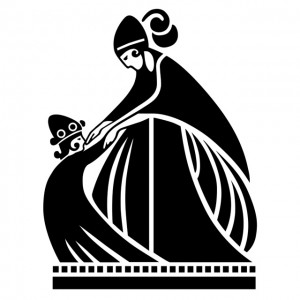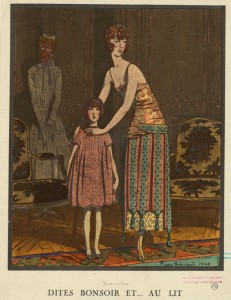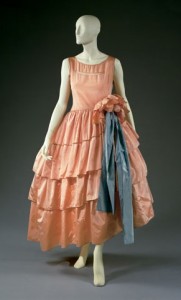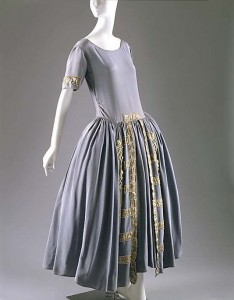It takes a talented designer to create a look that both mothers and daughters not only want to wear but can wear. Such is the case with Jeanne Lanvin. If there is any doubt about who she created her brand for, at least in the beginning, look no further than the Lanvin company logo: a mother and child holding hands.
Lanvin’s journey from teen dress shop worker, to hatmaker, to one of the most influential designers of the 1920s, is rather unconventional. She was born in the fashion mecca of Paris in 1867 and was the oldest of 11 children. In a family that large, it was not unusual for the elder siblings to work, so by the time she was 13 years old, Lanvin was making and delivering hats for one of the queens of hat design, Suzanne Talbot. When she was 23, Lanvin opened her own hat boutique. In 1897, her daughter Marie-Blanche was born, indirectly setting Lanvin on the next leg of her career path.
Lanvin adored her daughter and made many of Marie-Blanche’s clothes. Her customers could not help but notice how stylishly her daughter was dressed. With encouragement from her customers, Lanvin started a children’s clothing line in 1908, but it was not long before she was making dresses for adult women, too. Her simple empire-waist gowns, velvet hats, and muffs trimmed with skunk got her name into Vogue for the first – but definitely not the last – time in 1909. According to Louise de Vilmorin, Jeanne Lanvin “dazzled everyone with her work, but she did it for the sake of dazzling her daughter.”
When Lanvin debuted the updated robes de style dress in 1919, she tapped into a market that wanted to look and feel pretty but also wanted clothing that was wearable. As the Jazz Age dawned, Lanvin resisted the trend toward boxy silhouettes that camouflaged the female figure and made clothing that enhanced it. Certainly, it is easy for a clothing designer to jump on whatever the fashion bandwagon of the moment might hold. It takes a visionary, however, to follow her own instincts and have those instincts be correct.
In addition to having the signature robes de style design, Lanvin also created a signature color. On a trip to Florence, Italy she was awed by a Fra Angelico fresco. She was particularly struck by the use of “quattrocento blue.” Lanvin incorporated it into her own work and over time the shade has come to be known as “Lanvin blue.”
From there Lanvin branched out to perfume, lingerie, sportswear, menswear, and even home décor. Her nephew said she was lucky that she was successful in whatever she tried. However, it was the craftsmanship, the attention to detail, and the appeal of her clothing to women of any age that made her fixture in the fashion world. On one hand it may seem that Lanvin swam against the tide of the Jazz Age, but the truth is she was right on time. A woman of independent vision with the ability to successfully go her own way is the epitome of the new woman of the era.
See more pictures of Lanvin’s designs on Pinterest.
Learn more about 1920s fashion history with the free email blog series 1920s Style Guide:
Debbie Sessions has been teaching fashion history and helping people dress for vintage themed events since 2009. She has turned a hobby into VintageDancer.com with hundreds of well researched articles and hand picked links to vintage inspired clothing online. She aims to make dressing accurately (or not) an affordable option for all. Oh, and she dances too.




